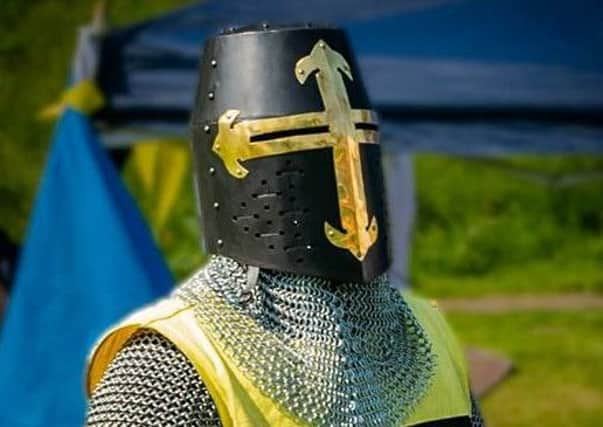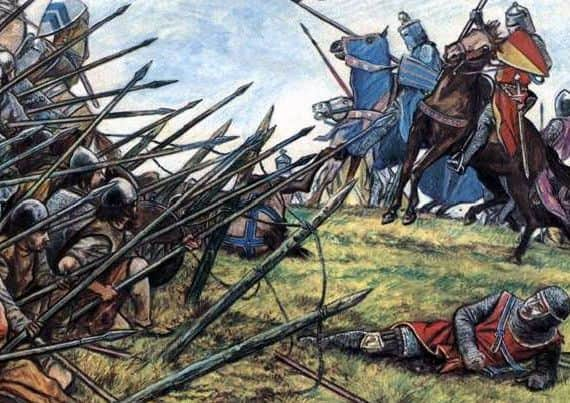Town's '˜massive' heritage set to come alive on Battle of Falkirk day


But as chainmail is figuratively burnished ahead of what’s promised to be a spectacular day on July 21 one key local player makes it clear the event is primarily meant for the people of Falkirk.
Unlike many other events which combine pageant with heritage the commemoration of the 1298 Battle of Falkirk will be completely free.
Advertisement
Hide AdAdvertisement
Hide AdDavid Reid, convenor of the Society of John de Graeme, is enthusiastic about the potential to bring this big summer occasion to a much wider audience.


He says close cooperation between the various official and community bodies involved will underpin its success.
But his biggest hope is that the town itself will benefit from a day featuring pageant, poignant ceremony, heritage and - unquestionably - spectacle.
“At the moment we have the fantastic attractions of the Kelpies and the Wheel”, he says, but a lot of people now agree there’s the chance to add to that success with something that reminds people of Falkirk’s massively important place in history - right in the heart of the town centre itself.”
Bodies including Falkirk Delivers and the Society of Sir William Wallace are involved in this year’s commemoration.
It will involve several completely new features, not least the return of Sir John de Graeme’s sword to Falkirk, to be exhibited in pride of place in Callendar House.
Sir John - the town’s very own medieval hero - was one of Wallace’s right hand men, but was among the many to die during a day of hideous slaughter.
He is buried in a magnificent tomb in the churchyard of Trinity Church.
Advertisement
Hide AdAdvertisement
Hide AdThousands of other Scots, their names lost to history, also perished in the debacle, leading some to question why such a terrible defeat needs to be commemorated at all.
David Reid says of the battle: “It was a pivotal event, one with huge consequences, yet I doubt whether many people in Falkirk High Street - shown the cross which remembers it - know very much about it, or even that it happened at all.
“It is their history and their heritage, and has no connection with modern day politics, but was a major historical event which deserves to be remembered.
“It has to be seen in the context of complex and turbulent times”.
The commemoration has many new features this year, including one guaranteed to shock at least some of those who witness it.
Wallace’s defeat in a conventional, formal battle against arguably the most powerful army in Western Europe - under its most accomplished war leader, the fearsome Plantagenet monarch Edward Longshanks - marked the end of an important chapter in the long struggle known as the Scottish Wars of Independence.
The chapter which followed Wallace’s betrayal and ritual murder by King Edward saw the tables completely turned under King Robert I, when he annihalated a very similar invading army at Bannockburn to (eventually) win Scottish independence.
Plantagenet dreams of an empire spanning the whole of the British Isles and France ultimately ended in complete failure.
Advertisement
Hide AdAdvertisement
Hide AdBut weren’t the Scottish foot soldiers who fought in these desperate battles mere vassals at the beck and call of their feudal masters?
Absolutely not, says Mr Reid, who makes clear that the evidence points solidly to a national war of resistance to a ruthless and rapacious foreign king.
“When Sir John Stewart died early on in the battle his 600 men from Bute did not flee, but fought on until the end”, he says.
“Scottish society, crucially including its religious leaders, was fully committed to the struggle for independence”.
It was a conflict with many twists and turns, involving Scottish civil war, a failed Scottish invasion of Ireland, the harrying of the North of England and the development of a Scottish political-military alliance with France.
Falkirk’s role in that maelstrom was pivotal, and the annual commemoration is about remembering that momentous events once happened within easy walking distance of the High Street.
Now it appears this year’s annual spectacle will be a key ingredient of a much wider plan to bring Falkirk’s rich history - modern and ancient - to a bigger local audience, also drawing visitors from across Britain and farther afield.
We’ll have more on the groups involved in the event, and the special features it will include, in the run-up to the big day on July 21.